POLLINATORS
For a large genera (>140 species) with a broad geographic range it is remarkable how little is known about the pollinators of Fritillaria. Constraints of time and logistics are understandable but deficiencies in the literature severely limit our ability to understand the diversity of floral traits.
Primarily Fritillaria are an outcrossing genus which encourage animal interaction to facilitate pollen transfer. Various floral rewards entice specific pollinating groups to visit the flowers and in the process visitors make contact with the plants reproductive organs both depositing and removing pollen.

Fritillaria Icones Image Set
The earliest observation for flower visitors in Fritillaria was made by the father of English ecology Gilbert White and recorded in The Natural History and Antiquities of Selborne (1789). He recorded small birds (probably Willow Warblers) running up the stems of F. imperialis, placing their head in the flower and drinking the nectar. It was not until two hundred years later that Burqez (1989) and Peters et al. (1995) recorded similar visits by Blue Tits and Great Tits to F. imperialis in other European gardens.
The key characters for pollination by passerine birds are a suitable landing platform, large pendant flowers, abundant dilute nectar and protruding stamens. So, although there are no pollinator records for F. imperialis in the wild, all these features are present in this obligate out-crosser.
Other bird pollination (ornithophily) has been recorded in F. gentneri and F. recurva from southern Oregon and Northern California (Pendergrass & Robinson 2003, Santana 1984). Anna’s and Rufus Hummingbirds (Calypte anna, Selasphorus rufus) are attracted by the species bright red flowers. As hummingbirds hover when collecting nectar no perch is required by either species.
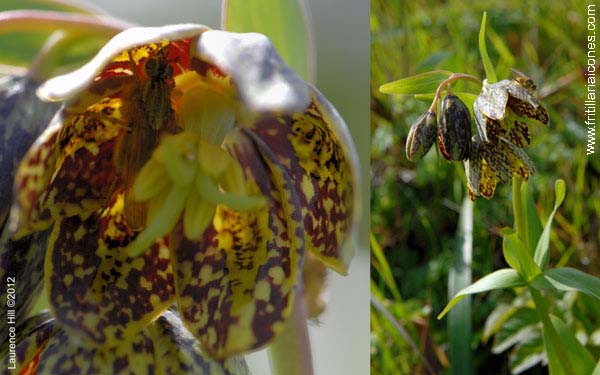
Scathophaga stercoraria (Yellow Dung-fly) taking nectar from Fritillaria affinis
23 m, Point Reyes, Marin Co., California, USA
Bird pollinated flowers tend to be odourless but flies are attracted by flowers that mimic the smell of dead animals or dung. F. camschatcensis is a typical fly pollinated (sapromyophily) species (Zox & Gold 2008); odoriferous scent, dark purple-black flowers, with nominal amounts of nectar and found at both high latitude and altitude where other pollinator groups are normally uncommon. F. camschatcensis does not offer a reward so the duration of fly visits can be short but this is offset by greater visitor frequency. Many other Fritillaria have a very unpleasant odour like F. agrestis (Stinkbells, King 2001) and are probably pollinated by flies.
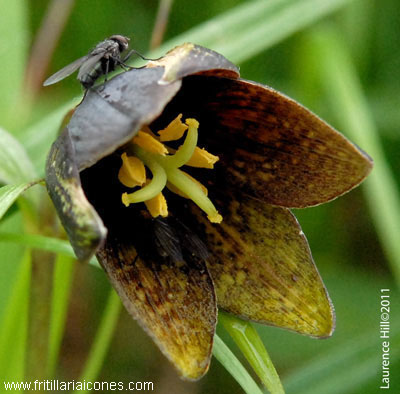
Fritillaria camschatcensis with two Calliphoridae sp. (Blow-fly)
2115 m, Mt Hakusan, Ishikawa Pref. Honshu, Japan
Bee pollination (Melittophily) is undoubtedly the most important pollinating group for angiosperms. F. meleagris, the type for the genus, secretes nectar with high sugar concentration consisting of sucrose, glucose and fructose in equal parts. It is visited by several bee species of which Queen Bumblebee have been shown to be the most effective pollinator (Zych & Stpiczyńska 2011). Only a few Fritillaria have been recorded as producing a strong sweet scent [F. liliacea (King 2001), F. obliqua (Beck 1953), F. striata (Santana 1984), F. stribrnyi, F. tortifolia (Roguz et al. 2018), F. yuminensis (Leon et al. 2009)] with many others exhibit a disagreeable or musky odour associated with wasp pollination. Unlike bees which collect both nectar and pollen, wasp feed on insects and only collect nectar from flowers.
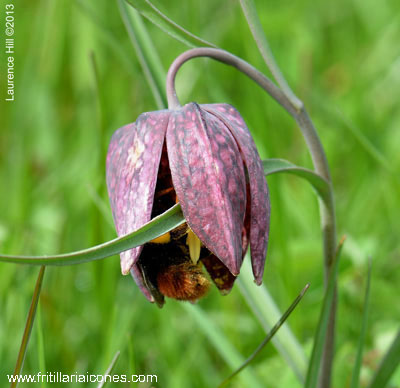
Fritillaria meleagris with Bombus lapidarius (Red-tailed Bumblebee)
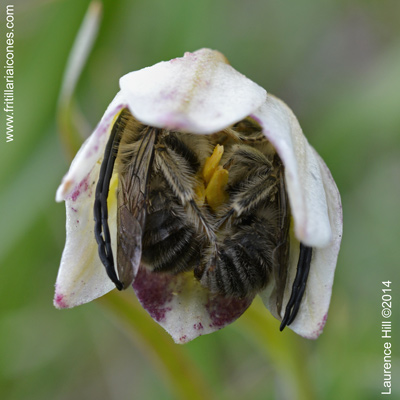
Two newly emerged Eucera (Long horned bees) on Fritillaria liliacea
175 m, San Francisco Fish and Game Refuge, San Francisco Water Department Lands, California, USA
Reproductive success can vary both between and within populations and this variation is particularly pronounced in Fritillaria. As spring flowering ephemerals they are often subject to marked weather fluctuations, too hot, too wet, late frosts, etc. These unfavourable conditions can reduce fruit set either as a result of functional deficiencies or reduced pollinator availability. To counter these limitations many Fritillaria target multiple pollinators, for example both bees and hoverflies (syrphid flies) have been recorded visiting F. ayakoana (Minagi et al. 2005).
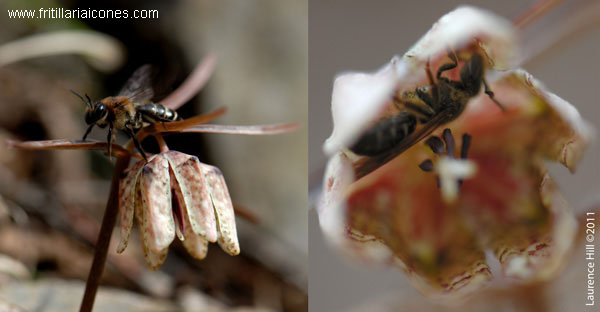
The very diminutive F. muraiana with Andrena sp. (Bee)
631 m, Naka-gun, Tokushima Pref. Shikoku, Japan
To understanding floral traits it is important to consider antagonistic selection pressures. Not all flower visitors provide pollinating services and some may predate on pollen or other floral parts. The presence of ungulates can select for smaller flowers and the pleiotropic effect of anthocyanins in vegetative tissues provides increased herbivore defence or drought tolerance but also results in a change to flower colour.
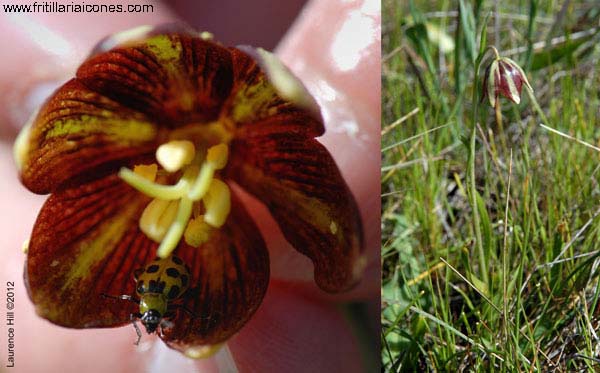
F. grayana with insect herbivore Diabrotica undecimpunctata
(Spotted cucumber beetle)
160 m, Hillsborough, San Mateo Co. California, USA
Fritillaria are a source of pollen and nectar for early emerging insects like solidary bees. In many habitats the number of other vernal species is low and consequently Fritillaria are key to the maintenance of these ecosystems. More research is essential in understanding pollinating interactions and the wider role in the ecosystem services provided by Fritillaria.
References
Beck C (1953) Fritillaries, A Gardener’s Introduction to the Genus Fritillaria, Faber & Faber, London
Burqez A (1989) Blue tits, Parus caeruleus, as pollinators of crown imperial, Fritillaria imperialis, in Britain, Oikos, 55: 335-340
King D (2001) The Genus Fritillaria, Bulbs of North America, Ed. McGary J, Timber Press & North American Rock Garden Society
Leon C, Fay M F & Rix M (2009) Fritillaria yuminensis, Curtis’s Botanical Magazine, t. 637
Minagi K, Yoshiya T & Hara T (2005) Notes on flower visitors and fruit set in Fritillaria ayakoana Naruhashi (Monocotyledoneae: Liliaceae), Bull. Shimane Nat. Museum of Mt Sanbe (Sahimel), 3: 57-60
Pendergrass & Robinson (2003) Recovery Plan for Fritillaria gentneri (Gentner’s fritillary), U.S. Fish and Wildlife Service, Portland, Oregon
Peters W S, Pirl M, Gottsberger G & Peters D S (1995) Pollination of Crown Imperial Fritillaria imperialis by Great Tits Parus major. J. Orn. 136: 207-212
Roguz K, Bajguz A, Gołebiewska A, Chmur M, Hill L, Kalinowski P, Schönenberger J, Stpiczyńska M, Zych M (2018) Functional Diversity of Nectary Structure and Nectar Composition in the Genus Fritillaria (Liliaceae), Frontiers Plant in Science 9:1246
Santana D O (1984) Taxonomy of Fritillaria (Liliaceae) series Falcatae Santana, Ph.D. dissertation , University of California, Davis, CA, USA
White G (1789) The Natural History and Antiquities of Selborne
Zox H & Gold W (2008) Ecology of Black Liliy (Fritillaria camschatcensis) A Washington State Sensitive Species, Douglasia Fall/Winter 17-22
Zych M & Stpiczyńska (2011) Neither protogynous nor obligatory out-crossed: pollination biology and breeding system of the European Red List Fritillaria meleagris L. (Liliaceae), Plant Biology 14(2): 285-294
Laurence Hill ©2020
![]()


